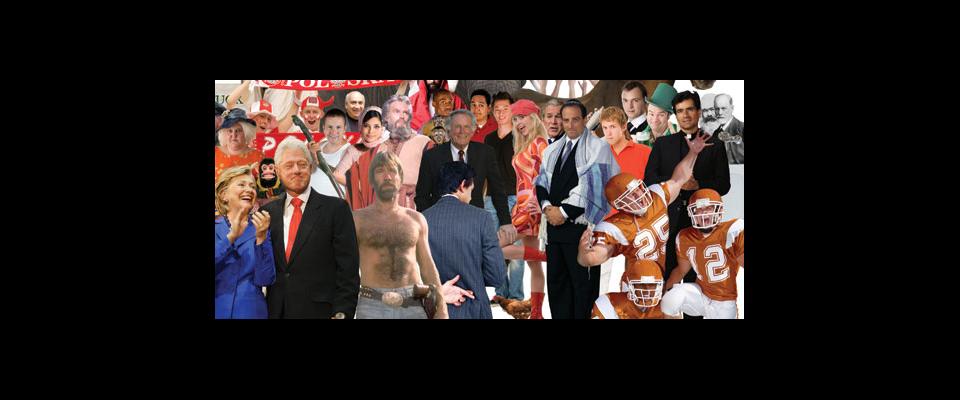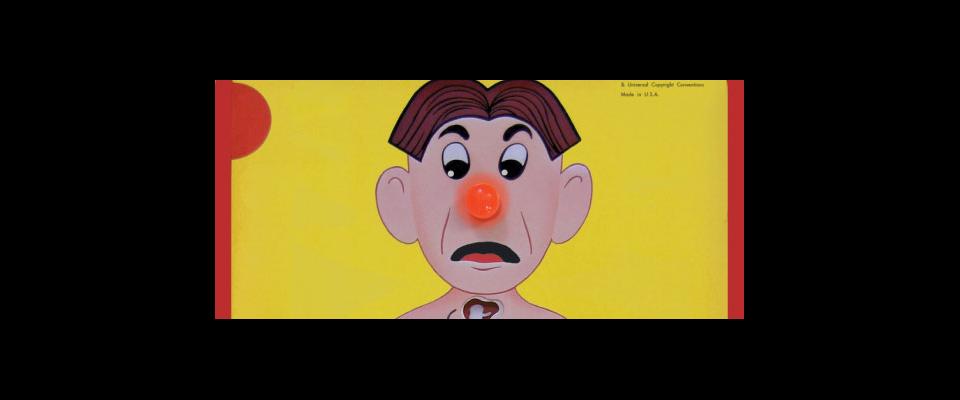Humor in the time of protest
By the time I got to the Pelican, the heyday of campus humor magazines was almost over. They were artifacts of the twenties and thirties, when a certain shared set of cultural assumptions ensured that every student would probably find the same things funny. Jokes about the cluelessness of Stanford students were always welcome. Foreigners and/or people with funny names were cause for mirth. So were the coy antics of coeds, the classroom gaffes of dumb football players, and the general otherworldliness of absentminded faculty members.
Here is a joke from a 1964 edition of the Pelican: “Boy: How many drinks does it take to make you dizzy? Girl: Three, and don’t call me Dizzy.”
Think of the cartoons in The New Yorker even today—they appeal to people from a specific culture: educated, ironic, prosperous, theatergoers and cocktail drinkers, heterosexual, anxious, aware of social issues but not consumed by them. The ideal Pelican reader, or so it seemed when I walked in the door in 1962, was the ideal New Yorker reader, except more interested in sex and beer and less interested in commuting from Connecticut.
Humor magazines were renowned for stealing venerated campus objects and hiding them, or putting them on top of the clock tower, or painting them with the colors of a hated rival. The Harvard Lampoon, then and now the apex of college humor magazines, still pulls the occasional prank, often involving celebrities. Famous Lampoon alumni include John Updike and Conan O’Brien—two of the whitest white people ever conceived in the womb of woman, which gets back to my point about college humor rags being “a white-person thing.” I was a white person, so I was fine with that. My mom had a subscription to The New Yorker as far back as I could remember.
In addition to being pranksters, college humor magazines were expected to be centers of transgressive behavior. My class was a little muted in that regard. The year before I got there, then-editor Don Wegars had been relieved of his post and almost kicked out of school for publishing a cover of a cartoon character holding an American flag with the Soviet hammer and sickle replacing one of the stars, and a speech balloon reading “Run it up yer ol’ wazoo.” Not exactly top drawer, either as satire or obscenity. There were apparently many hilarious conversations about the exact meaning and/or location of the “wazoo,” but the administration was not amused. Meanwhile, across the Bay, a riot broke out in City Hall during the hearings of the House Un-American Activities Committee. The Berkeley administrators didn’t realize it yet, but they would soon be contending with behavior far more transgressive than anything having to do with the word “wazoo.”
The California Pelican was housed in a low faux-Maybeck building on Strawberry Creek, with a large brass pelican out front. The building had been a gift from a used-car dealer named Earle C. Anthony on the condition that it be occupied in perpetuity by The Pelican. “Perpetuity” lasted about 50 years; the University wiggled out of the codicil and gave the building to some assistant vice president as a private retreat and love nest.
I made that last part up. It was humor—the kind of humor The Pelican would have published. Not really that funny, a little sex thrown in, a germ of truth—Pelican humor.
My own memories of the Pelican blend into one long, blissful afternoon. By that time, I had given up going to classes, and the Pelican building was a congenial hideout. The staff were good friends. Dick Corten, editor of a previous incarnation of this very magazine, was the leader of the gang. Susie McCorkle, who became the jazz singer Susannah McCorkle and committed suicide several years ago, was the token woman. Bob Weider, who went on to make a fine career as a humor writer, was the zany wise guy. Wandering in occasionally was Joel Beck, who achieved considerable fame as an underground cartoonist. I have a first edition of Lenny of Laredo that is so valuable I have forgotten where I hid it.
Reviewing an old bound edition of the Pelican circa 1964–65, it’s clear that I wrote a great deal. I found I could produce copy very quickly—not, upon reflection, very well, but Lord I had quantity! I think I was supposed to be the editor of The Pelican that year, although I had already been dismissed from the University for failure to attend classes.
That’s OK, though. Joel Beck never even enrolled.
After those afternoon respites at The Pelican, I would usually go down to Sproul Plaza and see what was going on. I was one of those who sat around the police car and listened to Mario Savio speak. I attended the meetings that resulted in the formation of the Free Speech Movement and the subsequent occupation of Sproul Hall and the arrest of 801 people. I attended all-night peace vigils and shivered on Sproul steps. I marched against the Vietnam War.
There was some cognitive dissonance there—The Pelican idyll on the one hand and the Sproul revolution on the other—but not as much as you’d think. Remember that the FSM was also a white-person thing, and it depended on shared assumptions and common rhetoric just as much as The Pelican did. The Pelican tried to write satires about civil rights and the war; I even wrote a parody of the FSM newsletter. But it had no bite; I was too close and too sympathetic to do anything more than make fun of the jargon-choked prose and humorless screeds.
Nothing was funny and everything was fun—that’s how I remember it now. The Pelican was about to die anyway. The specific goals of the FSM were realized, and now very few people can even remember what they were. All very ironic, and this is the Age of Irony, so let’s just say we did our part to usher in the era of “air quotes.” You’re welcome, little ones.






















